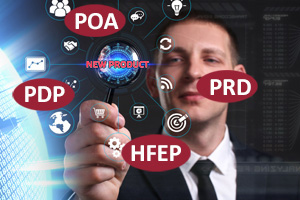By Robert Andrews, VP Business Development
 Defining key product requirements for a new medical device is a critical first step in the product development process. This activity establishes a direction to guide the product development effort and is proven save time and money. Without definition, effort may potentially become wasted when engineering activities run astray are not clearly focused on contributing to the development goals.
Defining key product requirements for a new medical device is a critical first step in the product development process. This activity establishes a direction to guide the product development effort and is proven save time and money. Without definition, effort may potentially become wasted when engineering activities run astray are not clearly focused on contributing to the development goals.
The business opportunity and rationale is assessed for releasing a new product or significantly upgrading an existing product. Ideas for these efforts are initiated by various functional units within the company. Customer sales and marketing personnel base their inputs on market feedback or exploration or by competitive pressures.
Whatever the origin, the http://crochet247.com/category/home-garden-decorations/ first step is the buy cheap disulfiram definition of the proposed new product (Phase 0). In this phase, the product is defined at a user and market level. It is important that the design input at this stage be as complete and consistent as possible, as there may be potential impacts to cost and time on subsequent development activities.
Product development phases begin with inputs, then the results of the development phases are defined in outputs. There are no required inputs to Phase 0, although new product or existing product initiatives are generally defined by the marketing and development teams. The outputs of the product definition phase should include an approved Product Opportunity Assessment (POA), a Product Requirements Document (PRD), Product Development Plan (PDP), and a Human Factors Engineering Plan (HFEP).
Product Opportunity Assessment (POA): This POA defines the business rationale, perceived market, and high-level definition of a new product or major upgrade to an existing product. Management approval should be required before design work is initiated on a new product or a major change to an existing product. This authorization can be in the form of the signed POA. Approval documentation becomes part of the Design History File. (DHF)
Product Requirements Document (PRD): A marketing PRD is developed based on the POA, user research, and input from the project team. The PRD should include all of the required product performance specifications as they are understood at the time. Not all requirements may be identified at this time. The PRD should specify all requirements at a level such that an engineering team designing to it would produce the desired product without additional input. It is during this time that the team must resolve incomplete, ambiguous or conflicting requirements.
Product Development Plan (PDP): The PDP defines the path to achieving the design requirements of the PRD by breaking the project into functional tasks and providing a road map to product release. The PDP specifies resource needs, milestone charts and contains an overall schedule. Certain activities defined in this procedure are required for every design project.
The PDP also determines project specific activities such as user human factors studies, interface reviews and testing activities that vary from project to project. It is the responsibility of the Program Manager to identify and plan for all activities to successfully complete the project. The PDP is updated periodically, at project phase reviews at a minimum, to reflect progress towards product release. The PDP is controlled by the Program Manager and each revision is archived in the DHF.
Human Factors Engineering Plan (HFEP): The HFEP is required per IEC 62366 and describes the planned human factors engineering activities. The HFEP also clarifies links to other engineering activities (e.g. risk analysis) and the end-products resulting from such technical activities. The plan will include the following activities:
- Research to understand the users and the use environment
- Analysis Activities
- Specification Activities
- Design Activities
- Activities
- Final Report
Summary
Developing a good product definition has several benefits to streamlining the product development process:
- Testing the business case for embarking on the program
- Refinement of the product concept
- Creating a clear direction to enable efficient use of product development resources
- Determination of program cost and timeline
- Alignment with FDA requirements for successful product approval
- Providing the foundation for manufacturing plan development